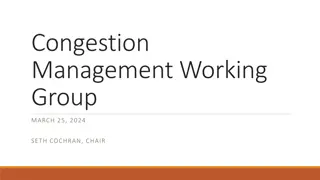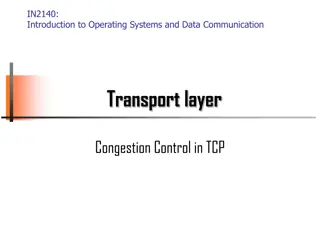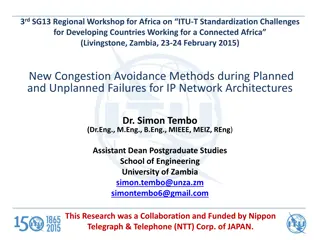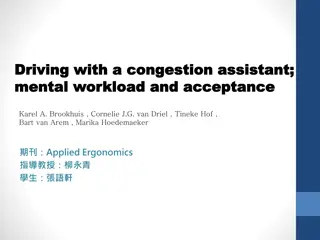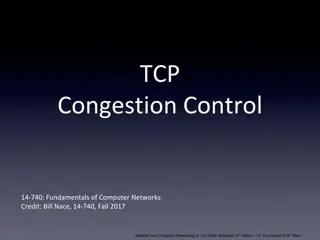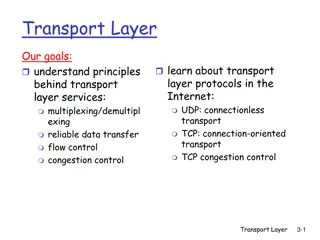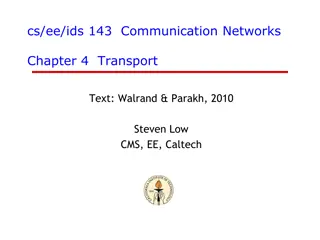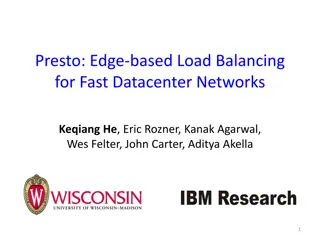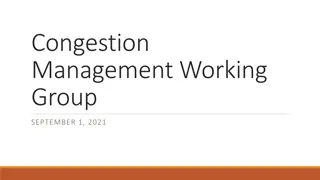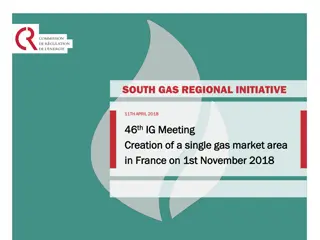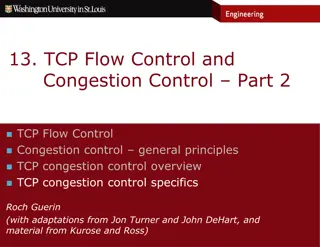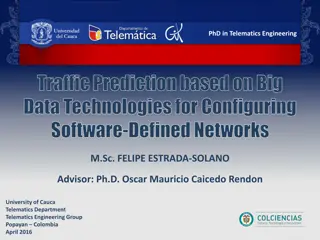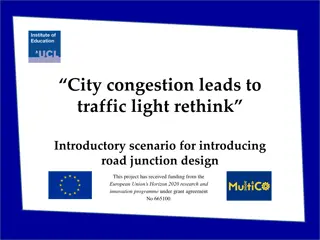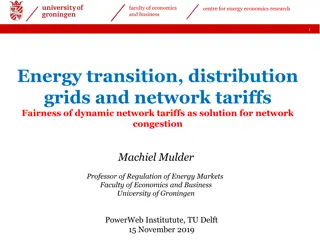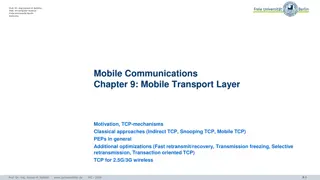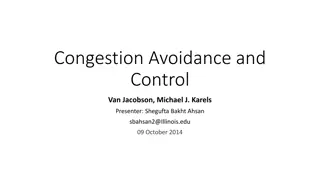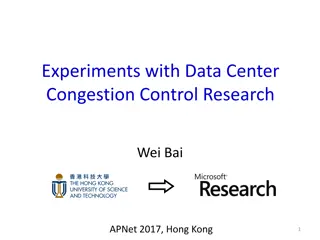Enhancing Data Center Network Performance Through Congestion Control Mechanisms
Explore the significance of low latency in data center networks and its impact on user experience and revenue. The research delves into congestion control mechanisms, network latency sources, and innovative solutions to reduce queueing delay and retransmission delay. Highlighted are the key goals, ongoing research efforts, and collaborative work aimed at optimizing flow completion time and enhancing overall data center application performance.
Uploaded on Oct 10, 2024 | 3 Views
Download Presentation

Please find below an Image/Link to download the presentation.
The content on the website is provided AS IS for your information and personal use only. It may not be sold, licensed, or shared on other websites without obtaining consent from the author.If you encounter any issues during the download, it is possible that the publisher has removed the file from their server.
You are allowed to download the files provided on this website for personal or commercial use, subject to the condition that they are used lawfully. All files are the property of their respective owners.
The content on the website is provided AS IS for your information and personal use only. It may not be sold, licensed, or shared on other websites without obtaining consent from the author.
E N D
Presentation Transcript
Congestion Control Mechanisms Congestion Control Mechanisms for Data Center Networks for Data Center Networks Wei Bai Microsoft Research Asia HotDC 2018, Beijing, China 1
Data Centers Around the World Google s worldwide DC map Facebook DC interior Microsoft s DC in Dublin, Ireland Global Microsoft Azure DC Footprint 2
Data Center Network (DCN) INTERNET Fabric 3
Data center applications really care about latency! 4
100ms slowdown reduced # searches by 0.2-0.4% [Speed matters for Google Web Search; Jake Brutlag] Revenue decreased by 1% of sales for every 100ms latency [Speed matters; Greg Linden] 400ms slowdown resulted in a traffic decrease of 9% [Yslow 2.0; Stoyan Stefanov] 5
Goal of My Research Low Latency Data Center Networks 6
Sources of Network Latency Queueing delay Moderate queueing is necessary for high throughput Excessive queueing only degrades latency Retransmission delay Fast retransmission: 1 RTT (100s of us) Timeout retransmission: several ms 7
My Research Work To reduce queueing delay PIAS [NSDI 15] minimizes flow completion time without prior knowledge of flow size info To reduce retransmission delay TLT (ongoing) eliminates congestion timeouts 8
PIAS PIAS Joint work with Li Chen, Kai Chen, Dongsu Han, Chen Tian and Hao Wang 9
Flow Completion Time (FCT) is Key Data center applications Desire low latency for short messages App performance & user experience Goal of DCN transport: minimize FCT Many flow scheduling proposals 10
Existing Solutions PASE PDQ pFabric SIGCOMM 13 SIGCOMM 14 SIGCOMM 12 All assume prior knowledge of flow size information to approximate ideal preemptive Shortest Job First (SJF) with customized network elements Not feasible for many applications Hard to deploy in practice 11
Question Without prior knowledge of flow size information, how to minimize FCT in commodity data centers? 12
Design Goal 1 Without prior knowledge of flow size information, how to minimize FCT in commodity data centers? Information-agnostic: not assume a priori knowledge of flow size information available from the applications 13
Design Goal 2 Without prior knowledge of flow size information, how to minimize FCT in commodity data centers? FCT minimization: minimize the average and tail FCTs of short flows & not adversely affect FCTs of large flows 14
Design Goal 3 Without prior knowledge of flow size information, how to minimize FCT in commodity data centers? Readily-deployable: work with existing commodity switches & be compatible with legacy network stacks 15
Our Answer Without prior knowledge of flow size information, how to minimize FCT in commodity data centers? PIAS: Practical Information- Agnosticflow Scheduling 16
PIAS Key Idea PIAS performs Multi-Level Feedback Queue (MLFQ) to emulate Shortest Job First (SJF) Priority 1 High Priority 2 Low Priority K 17
PIAS Key Idea PIAS performs Multi-Level Feedback Queue (MLFQ) to emulate Shortest Job First (SJF) Priority 1 Priority 2 Priority K 18
PIAS Key Idea PIAS performs Multi-Level Feedback Queue (MLFQ) to emulate Shortest Job First (SJF) In general, PIAS short flows finish in higher priority queues while large ones in lower priority queues, emulating SJF, effective for heavy tailed DCN traffic. 19
How to implement PIAS? Implementing MLFQ at switch directly not scalable Requires switch to keep per-flow state Priority 1 Priority 2 Priority K 20
How to implement PIAS? Decoupling MLFQ Stateless Priority Queueing at the switch (a built-in function) Stateful Packet Tagging at end hosts (a shim layer between TCP/IP and NIC) Priority 1 - K priorities: Pi 1 i K K 1 thresholds: j1 j K 1 - Threshold from Pj 1 to Pj is: j 1 Priority 2 K priorities: Pi 1 i K K 1 thresholds: j 1 j K 1 Threshold from Pj 1 to Pj is: j 1 Priority K K priorities: Pi 1 i K K 1 thresholds: j 1 j K 1 Threshold from Pj 1 to Pj is: j 1 21
How to implement PIAS? Decoupling MLFQ Stateless Priority Queueing at the switch (a built-in function) Stateful Packet Tagging at end hosts (a shim layer between TCP/IP and NIC) i Priority 1 - K priorities: Pi 1 i K K 1 thresholds: j1 j K 1 - Threshold from Pj 1 to Pj is: j 1 Priority 2 K priorities: Pi 1 i K K 1 thresholds: j 1 j K 1 Threshold from Pj 1 to Pj is: j 1 Priority K K priorities: Pi 1 i K K 1 thresholds: j 1 j K 1 Threshold from Pj 1 to Pj is: j 1 22
Threshold vs Traffic Mismatch DCN traffic is highly dynamic Threshold fails to catch traffic variation mismatch 10MB Ideal, threshold = 20KB 10MB High Low Too small, 10KB ECN 20KB 23 Too big, 1MB
PIAS in 1 Slide PIAS packet tagging Maintain flow states and mark packets with priority PIAS switch Enable strict priority queueing and ECN PIAS rate control Employ Data Center TCP to react to ECN 24
Prototyping & Evaluation Prototype implementation http://sing.cse.ust.hk/projects/PIAS Testbed experiments and ns-2 simulations 1G in testbed experiments 10G/40G in simulations Realistic production traffic Schemes compared DCTCP (both testbed and simulation) pFabric (only simulation) 25
Testbed: Small Flows (<100KB) 8 3 PIAS DCTCP 6 49% 2 FCT (ms) FCT (ms) 34% TCP 4 1 2 0 0 0.5 0.6 0.7 0.8 0.5 0.6 0.7 0.8 Load Load Web Search Data Mining PIAS reduces average FCT of small flows by up to 49% and 34%, compared to DCTCP. 26
NS-2: Comparison with pFabric 200 200 PIAS pFabric 150 150 FCT (us) FCT (us) 100 100 50 50 0 0 0.5 0.6 0.7 0.8 0.5 0.6 0.7 0.8 Load Load Web Search Data Mining PIAS only has a 1% performance gap to pFabric for small flows in the data mining workload. 27
PIAS Recap PIAS: practical and effective Not assume flow information from applications Information-agnostic Enforce Multi-Level Feedback Queue scheduling FCT minimization Use commodity switches & legacy network stacks Readily deployable 28
TLT Ongoing work with Yibo Zhu, Dongsu Han, Byungkwon Choi, Hwijoon Lim 29
Lossy & Loss-Less Lossy Ethernet Packet losses increase end-to-end latency Loss-Less Ethernet Use PFC to eliminate congestion packet losses Cause new problems: HoL blocking, deadlock Can we get benefits from both sides? 30
Revisit the Impact of Packet Losses Packet losses in the middle Fast retransmissions: 1 RTT (100s of us) Packet losses at the tail Timeout retransmissions: several ms 1 2 3 1 2 ACK1 ACK2 ACK1 3 ACK1 2 3 31
Design Goals Eliminate timeout retransmissions Small side effects -> Rarely/Never trigger PFC Work with commodity switch hardware Timeout-Less Transport (TLT) 32
Design Rationale Some packets are important as their losses may cause timeouts For example, last data packet in a message Only guarantee important packets lossless Unimportant packets can be dropped as usual 33
Design Challenges How to select important packets? As few as possible For both rate/window protocols How to guarantee important packets lossless? Separating important and unimportant packets into two queues causes out-of-order problem 34
Important Packets of Rate Protocols Last packet of the message must be important One of every N packets is selected as the important one Further reduce retransmission delay 35
Important Packets of Window Protocols Insight: at least one in-flight packet is important In the first window, randomly choose one important packet When receiving an ACK for an important packet If the window allows, transmit a new packet (or a lost packet) and mark it as important Otherwise, transmit the last unacknowledged packet and mark it as important 36
Guarantee Important Packets Lossless Switch proactively drops unimportant packets Drop thresh. Important Unimportant 37
Guarantee Important Packets Lossless Switch proactively drops unimportant packets Leave buffer headroom for important packets Avoid triggering PFC Enable PFC to handle extreme cases For example, a large # of single-packet flows 38
Ongoing & Future Work Further reduce the size of important traffic How to choose the dropping threshold for unimportant packets Interaction with congestion control algorithms Prototype implementation and evaluation 39
Summary PIAS uses MLFQ to reduce the queueing delay (completion time) for small flows TLT ensures that every congestion loss can be recovered using fast retransmission 40
Thank You! 41



